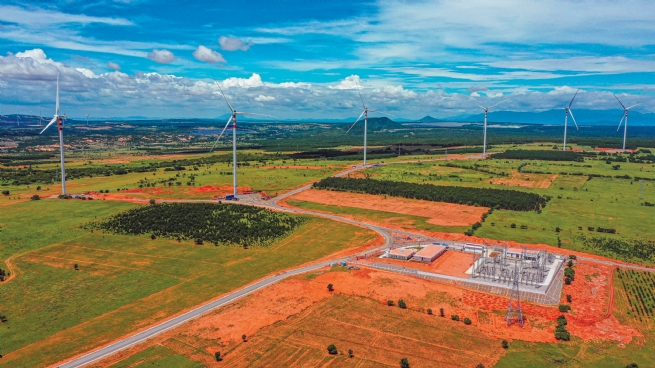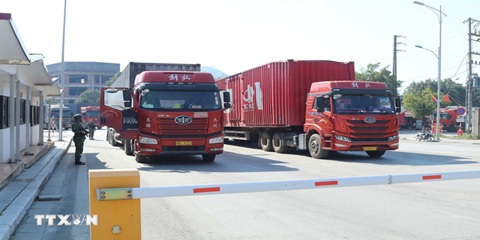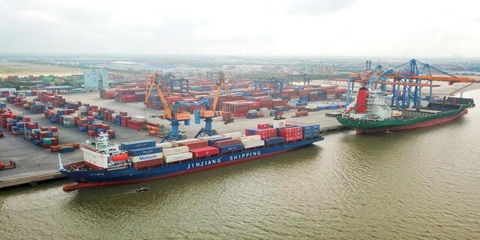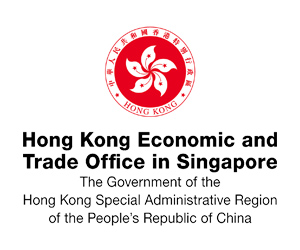Want to be in the loop?
subscribe to
our notification
Business News
VIETNAM CHARTS SUSTAINABLE PATH TO GREEN GROWTH
Vietnam has seen one of the fastest per capita carbon emissions growth rates globally over the past three decades. To achieve its net-zero emissions goal, Vietnam must find ways to further reduce emissions while ensuring that energy remains affordable and its industrial sectors maintain competitiveness.

Businesses recognize many benefits provided by rooftop solar power
Although Vietnam’s contribution to global greenhouse gas emissions is currently about 0.8% (equivalent to 355 million metric tons of CO2 in 2020), from 1990 to 2021, its CO2 emissions grew nearly three times faster than GDP growth.
Laying the groundwork for a green future
Vietnam's goal of becoming a high-income economy by 2045 is closely tied to its ability to follow a sustainable development path and build resilience. According to a recent World Bank report on greener growth, Vietnam needs to sustain annual GDP growth of 6-6.5% over the next two decades to reach this goal. However, the country is likely to face climate change risks. Heatwaves, storms and rising sea levels threaten farmlands, factories and urban areas - the engines of growth, and the infrastructure that connects people and markets. Typhoon Yagi offered clear evidence that these threats are not distant possibilities but a present reality. According to expert forecasts, without adaptation efforts, climate change could significantly hinder Vietnam's ability to become a high-income country by mid-century.
Besides, Vietnam is among the highest greenhouse gas emitting countries in East Asia, with 1.1 kg of CO2 emissions per dollar of GDP (compared to 0.7 kg and 0.4 kg in China and the Philippines, respectively) while the carbon content of its exports makes up 36% of its total CO2 emissions, one of the highest rates in the region.
The government has begun laying the foundation for a greener and more resilient future, including establishing the Mekong Delta Coordination Council which brings together authorities, local communities and the private sector to align investments and actions in addressing climate risks across the delta. The Vietnamese government also issued a sustainable coastal resource use plan to transform coastal areas into cultural centers, economic opportunities and sustainable prosperity hubs.
Regarding mitigation efforts, Vietnam has rapidly advanced its energy transition. From 2019 to 2023, its installed solar power capacity surged from 4.5 GW to over 17 GW, driven by preferential policies and private investment. The eighth National Power Development Plan (PDP8) targets 73 GW of solar capacity by 2030, over five times higher than the previous target of 12.8 GW. The wind power target will nearly double, from 21 GW to 38 GW. At the same time, Vietnam is accelerating preparations for an emissions trading system (ETS), with pilot programs expected to be launched in 2025 and fully implemented in 2028.
While the country’s economic growth model remains carbon-intensive, the private sector in Vietnam has started to seize green growth opportunities. Over the past decade, green economic activities have grown rapidly and now contribute importantly to GDP. The government estimated that green sectors generated US$6.7 billion in 2020, accounting for 2% of GDP, with annual growth of 10-13% in 2018-2020, created over 400,000 jobs, more than half coming from manufacturing equipment, machinery and components for clean and renewable energy production. Vietnam also ranked 8th globally and first in East Asia-Pacific in terms of cross-border clean energy investment relative to GDP during 2016-2020.
Nevertheless, it is worth noting that Vietnam experienced rapid growth in domestic green energy capacity amid sharply declining costs, but it faced institutional challenges in developing this sector. The share of electricity generated from wind and solar energy rose from virtually zero in 2018 to 13% of total electricity production, largely due to a significant drop in the levelized cost of electricity (LCOE) for solar power after 2019, when the country introduced favorable feed-in tariffs to boost solar energy development. Although no other country in the world has added renewable energy at such a high share of total installed capacity in such a short period, this sector continues to face institutional and policy-related obstacles in onboarding to this new generation capacity, resulting in much of the added capacity awaiting grid integration.

Vietnam is one of the most favorable countries in Southeast Asia for wind and solar power development
Integrating national policy with incentive mechanisms
Vietnam’s favorable position offers the private sector significant opportunities to tap into the growing global demand for green technologies, goods and services, underpinned by abundant potential and low-cost green energy. According to the World Bank's analysis, Vietnam is one of the most advantaged countries in Southeast Asia for the development of wind and solar power, positioning it for a new form of competitive advantage, with an estimated technical potential of up to 1,000 GW per year, driven primarily by wind resources. In addition, the country has the lowest levelized cost of electricity (LCOE) for wind power in ASEAN, and among the lowest for solar power. Similarly, offshore wind power projects combined with battery are expected to become more cost-effective than new coal-fired or gas-fueled power plants in the second half of the 2030s. These create promising investment opportunities for the business community and government stakeholders in Vietnam to attract companies seeking cleaner production models, such as members of the RE100 Climate Group.
Especially, the private sector is central to Vietnam’s efforts to reduce emissions and transition to a low-carbon economy. Mobilizing private capital is crucial to meet investment needs, particularly in sectors where private businesses can drive efficiency and innovation. So far, private investment has played a major role in Vietnam’s renewable energy capacity. For example, solar power grew from virtually zero to 17 GW now largely due to private participation. Besides renewable energy, the private sector can also help improve energy efficiency and cut emissions across various industries.
According to the World Bank, with its domestic and international commitments to net-zero emissions, Vietnam should adopt a comprehensive approach that integrates national policies with incentives, regulations and standards across key emitting sectors such as energy and transport. Current policies largely rely on planning mechanisms such as renewable energy targets in the National Power Development Plan. Shifting this policy package toward a more market-based approach could improve efficiency and lower emission reduction costs by leveraging the strengths of market mechanisms. Market instruments such as carbon pricing can shift relative prices and this will accelerate the adoption of low-carbon technologies by making them more competitive. These tools include a pilot emissions trading system (ETS) planned for 2025, with full implementation expected in 2028. Vietnam is also participating in voluntary carbon markets, alongside transactions under Article 6 of the Paris Agreement for carbon credit certification and trading. A carbon tax, if introduced, will complement the ETS and further support Vietnam’s ambitious net-zero target by 2050.
In particular, improving access to green finance and easing regulatory constraints will facilitate the private sector to invest in clean infrastructure and technologies.
Source: VCCI
Related News

VIETNAM’S SEAFOOD EXPORTS HIT OVER US$10 BILLION IN JAN-NOV
Seafood export revenue in November alone amounted to nearly US$990 million, up 6.6% year-on-year. Key product groups posted solid gains. Shrimp exports rose 11.7% to over US$385 million, supported by strong demand for whiteleg shrimp and lobster. Tra fish shipments increased 9.7% to almost US$197 million, while marine fish, squid, and mollusk exports maintained their recovery.

VIETNAM’S AGRO-FORESTRY-FISHERY EXPORTS HIT NEW RECORD IN JAN-NOV
Vietnam’s agro-forestry-fishery export revenue reached an estimated US$64.01 billion in the first 11 months of 2025, up 12.6% year-on-year and surpassing the full-year record of US$62.4 billion set in 2024. Agricultural exports reached US$34.24 billion, up 15% year-on-year, while livestock products brought in US$567.4 million, a 16.8% increase. Seafood exports rose 13.2% to US$10.38 billion, and forestry products earned US$16.61 billion, up 5.9%.

HANOI REPORTS RECORD-HIGH BUDGET REVENUE IN 2025
Hanoi’s budget revenue is estimated to reach VND641.7 trillion in 2025, the highest level ever recorded and nearly 25% above the revised target, according to a report by the municipal government. Data from the city’s socioeconomic performance review shows that total state budget collections in 2025 are projected to reach 124.9% of the adjusted plan and rise 24.9% from 2024, the Vietnam News Agency reported.

VIETNAM, CHINA TO PILOT TWO-WAY CARGO TRANSPORT AT LANG SON BORDER
Vietnam and China will launch a one-year pilot program on December 10 to allow two-way cargo transport through the Huu Nghi–Youyi Guan international border gates in Lang Son Province, reported the Vietnam News Agency. The Dong Dang-Lang Son Economic Zone Management Board said the trial aims to reduce transport costs and improve customs clearance capacity.

VIETNAM’S IMPORT-EXPORT VALUE NEARS US$840 BILLION IN JAN-NOV
The total value of Vietnam’s imports and exports was nearly US$840 billion between January and November this year, the highest level ever recorded, according to the National Statistics Office. In its latest report on the country’s socio-economic performance, the National Statistics Office highlighted a series of positive economic indicators, with trade emerging as one of the strongest drivers of growth.

OVER 19 MILLION INTERNATIONAL VISITORS COME TO VIETNAM IN JAN-NOV
Vietnam received more than 19.1 million international visitors in the first 11 months of 2025, a 20.9% increase year-on-year and the highest level ever recorded, according to the National Statistics Office. The figure surpasses the full-year record of 18 million arrivals set in 2019, before the Covid-19 pandemic. Nearly two million foreign visitors arrived in November alone, up 14.2% from October and 15.6% from the same period last year.
























